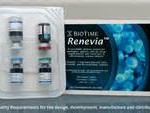Wound healing and soft tissue regeneration requires the production of collagen and extracellular matrix to lay the foundation for cellular ingrowth from fibroblasts and epithelial cells for overgrowth. (coverage) A wide variety of biologic signals and other factors are required for this process to occur in a timely manner. Many wound healing products have appeared over the years, each with their own advantages and disadvantages.

Premvia hydrogel can be useful for a wide variety of wounds from burns, ulcers, surgical insult, delayed healing. While this is useful at the present for open wounds, the future of this product lies in the company’s future plans to use it as a carrier of stem cells. A clinical trial in Europe is ongoing in that regard. (Renevia) This will be a much more difficult FDA hurdle to overcome but the product is worth watching to see if it will eventually turn into an injectable product that can be cell-loaded.
Dr. Barry Eppley
Indianapolis, Indiana


